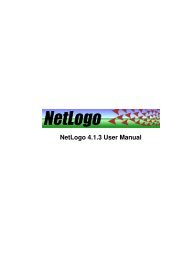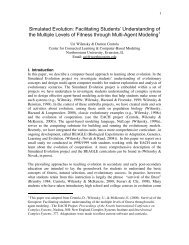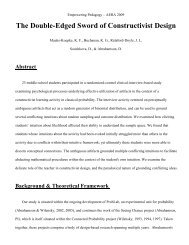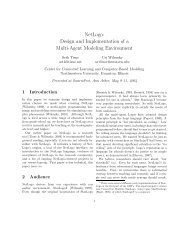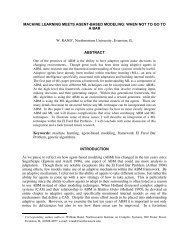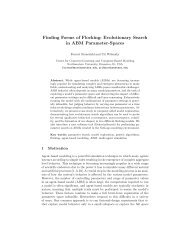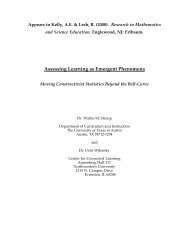Design Guidelines for Agent Based Model Visualization
Design Guidelines for Agent Based Model Visualization
Design Guidelines for Agent Based Model Visualization
You also want an ePaper? Increase the reach of your titles
YUMPU automatically turns print PDFs into web optimized ePapers that Google loves.
<strong>Design</strong> <strong>Guidelines</strong> <strong>for</strong> <strong>Agent</strong> <strong>Based</strong> <strong>Model</strong> <strong>Visualization</strong><br />
1.4<br />
2.1<br />
2.2<br />
2.3<br />
2.4<br />
2.5<br />
2.6<br />
2.7<br />
constrained representations such as maps in GIS or plots in spreadsheets. The design of these<br />
constrained representations is possible to automate, <strong>for</strong> example the computer can assist the user in<br />
creating maps and a wide variety of diagrams and plots. However, this is difficult to achieve in ABM<br />
visualization given the diversity of ABM depictions. The nature of agent-based modeling frameworks<br />
demands a wide array of graphic representations (see Figure 2) that are usually custom-made <strong>for</strong> each<br />
model. Thus, well-designed ABM visualizations requires an in-depth knowledge of visualization<br />
guidelines and the skill to use those guidelines to craft clear and aesthetic visualizations.<br />
In this paper, we first describe and categorize ABM visualizations created in NetLogo (Wilensky<br />
1999a). This categorization aims to introduce the reader to the diversity of visualizations in ABM and<br />
some of the better practices in ABM visualization design. Afterwards, we discuss how Gestalt<br />
psychology, semiology of graphics and scientific visualization can in<strong>for</strong>m the design of ABM<br />
visualizations. Through this discussion we hope to introduce ABM developers to techniques <strong>for</strong><br />
improving their visualizations such as, <strong>for</strong>eground/background segregation, in<strong>for</strong>med use of visual<br />
variables, and removal of visual interferences. Then, we present the goals <strong>for</strong> applying these<br />
techniques: to simplify, emphasize and explain the visualization. Finally, we examine a redesign of an<br />
ABM visualization to illustrate these ideas.<br />
Background<br />
<strong>Visualization</strong> guidelines <strong>for</strong> an agent-based model draw from both aesthetic and cognitive design<br />
traditions. Aesthetic design techniques have a long history originating in artistic and graphic design<br />
developed over centuries. However, cognitive design techniques were only studied recently,<br />
originating with Gestalt psychology research in the early twentieth century.<br />
Aesthetic visualization techniques involve color theory, image composition, and other visual<br />
considerations seeking to remove discordant structures and highlight a message. A detailed discussion<br />
of graphic aesthetics is outside the scope of this paper, but the reader can gain some basic knowledge<br />
in this area by consulting introductory references (Pipes 2004; Maeda 1999). However, to effectively<br />
employ aesthetic design, reading art and design theory is insufficient, it is a craft primarily acquired by<br />
actively practicing with an expert. Nevertheless, aesthetic designs do follow certain general rules such<br />
as, balance, unity, harmony, scale and proportion, and contrast and emphasis. By understanding these<br />
design criteria the developer of ABM visualizations should be capable of articulating when, how and<br />
why a visualization is pleasing to the eye.<br />
Cognitive visualization techniques tend to be more explicit than aesthetic techniques and there<strong>for</strong>e can<br />
be more easily conveyed and systematized. Cognitive visualization techniques have been developed in<br />
several fields, starting in Gestalt psychology (Wertheimer 1923).<br />
Gestalt psychology is a theory of mind with the motto 'The whole is greater than the sum of its parts'.<br />
Gestalt psychologists studied with mechanisms of visual recognition of figures and whole <strong>for</strong>ms from<br />
a collection of simple lines and curves.<br />
Jacques Bertin developed another significant visualization framework in his seminal book, The<br />
Semiology of Graphics (Bertin 1967). In his work, Bertin, defines a coherent and comprehensive<br />
symbol scheme where he presents visual variables and studies the type and quantity of in<strong>for</strong>mation<br />
they can convey.<br />
There are many other significant frameworks that have been developed to study visualization,<br />
particularly in the field of statistics. (Tukey 1977; Tufte 1983).<br />
In the 1980s, with the advent of personal computers, scientific visualization became a distinct field,<br />
http://jasss.soc.surrey.ac.uk/12/2/1.html<br />
11/20/09 3:30 PM<br />
Page 3 of 32



